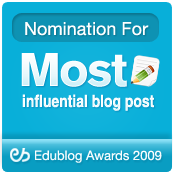by John T. Spencer
My son colored ten pages in his coloring book. He improved in shading and in understanding the colors of shapes. Beyond that, though, he didn't learn much. It was a decent escape and a lot of fun, but it wasn't particularly creative. Most of the deeper thinking had been manufactured in advance.
Yesterday he drew monsters: hairy monsters, angry monsters, lonely and misunderstood monsters. Some had three eyes or four eyes and one had none eyes and had learned how to see by feeling the temperature of things around him. The monsters had names and stories and occasionally a setting or two. Mostly plot, though. The monsters were actively engaged in creating and destroying and saving and losing. Joel shifted from creative thought to analytical thought in a constant ebb and flow that simply doesn't happen on a coloring book.
The monsters weren't as pretty as the coloring books. I guess monsters aren't supposed to be pretty, so it's okay. They were raw and honest and unfiltered. The coloring book felt like Celine Dion. The monsters felt like Iron and Wine.
My friend Javi asked his class last year to brainstorm a list of social issues within the Maryvale community. Students began tracing their hands, drawing big bubbles and trying their best to remember how they were supposed to brainstorm. A list would have worked well. What he didn't need was a bunch of hands or bunnies or boxes. "They were recreating worksheets, John. And that was the problem. Teachers had heard about graphic organizers, so they started trying to find as many as possible and so many of them were simply worksheets. Nothing that engages the learner in actually thinking. The creative and critical thinking had been done for them."
I'm not against graphic organizers. However, the litmus test of a graphic organizer should be:
- Does it provoke students to think deeper about the subject?
- Does it enable students to organize their own thoughts without having to learn a new structure?
If the answer is no to either question, I won't use the graphic organizer in my class.
Sometimes I think the most hyped-up technology seems to be a computerized version of a coloring book. Xtranormal videos are neat, but sock puppet theater might actually provoke deeper thought. Wordle has its place, but asking students to analyze word count on a spreadsheet might force them to be a little more analytical. Prezis can be pretty, but if there aren't the right inquiry questions, it simply becomes an online version of a poster board. It's not that any of those tools are inherently bad. However, they often fail to lead to learning, because the the program has already done the thinking for the students.
Sometimes a shared document, a podcast, a from-scratch video (using cameras) might look a little less flashy, but they empower students to take ownership of their own learning. Something as uncool as a spreadsheet can be powerful, because it reduces the time spent on rote skills and allows students to analyze data. A concept map might not buzz and beep and talk to the students, but it mirrors the way we make mental connections.
Ultimately, the question guiding all technology integration should be, "How does this change the way students think?"
If the organizing and creating are all prefabricated, it's a worksheet and a coloring book - sometimes a very slick version, but still a coloring book. If, however, the medium allows students to think deeper about life than it's worth using.
John T. Spencer is a teacher in Phoenix, AZ who blogs at Education Rethink. He recently finished two books, Pencil Me In, an allegory for educational technology and Drawn Into Danger, a fictional memoir of a superhero. You can connect with him on Twitter @johntspencer








Thank you for this fantastic post. You have traced a history of pseudo-teaching from colouring sheets through worksheets and graphic organizers to too-slick digital tools. I am reminded of something I heard Lynda Barry say in a radio interview recently, talking about her book "Picture This" - that for the first seven or so years of our lives, the page is a place and not a product. Little kids naturally go there, they exist there, they think and create. Slick packaging probably helps shut down creativity - the kid way no longer seems to look good enough. The opposite is true, though - as adults, we could all benefit from a little monster drawing ourselves!
ReplyDeleteawesome insight. thanks. i am inspired.
ReplyDeleteI liked your insight here. I think anything we use that is cookie cutter must be adapted to our kids. I like wordle as a review...I put in the text and project the wordle then we discuss why certain words appeared more on the cloud than others. It gets kids thinking about those concepts, they ask questions, see relationships, get clarification. They are pretty, but they can be used for analysis as well....
ReplyDeleteI'm a new follower of this blog and am totally inspired, so thanks, for starters.
ReplyDeleteIn my district we've adopted Thinking Maps, a series of 6(?) graphic organizers that can be used in any potential idea organizing activity. There are no gimmicks in this program - organizers are very simple and follow basic logic. I would highly recommend them.
Being fairly new to education, "graphic organizer" is a buzz phrase that I have heard more than others. You have hit the nail right on the head in regards to why we have to be careful and constantly think about why we use what we use, instead of taking its popularity for granted.
ReplyDeleteWell written - thankyou for putting words to some of my current dilemmas.
ReplyDeleteThought provoking and inspiring.